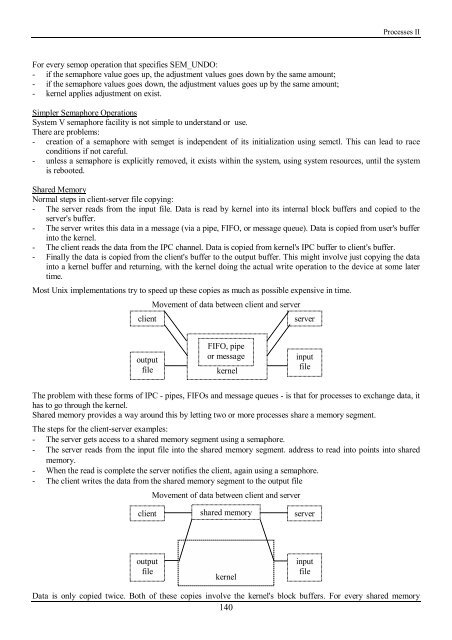Create successful ePaper yourself
Turn your PDF publications into a flip-book with our unique Google optimized e-Paper software.
Processes II<br />
For every semop operation that specifies SEM_UNDO:<br />
- if <strong>the</strong> semaphore value goes up, <strong>the</strong> adjustment values goes down by <strong>the</strong> same amount;<br />
- if <strong>the</strong> semaphore values goes down, <strong>the</strong> adjustment values goes up by <strong>the</strong> same amount;<br />
- kernel applies adjustment on exist.<br />
Simpler Semaphore Operations<br />
System V semaphore facility is not simple to understand or use.<br />
There are problems:<br />
- creation of a semaphore <strong>with</strong> semget is independent of its initialization using semctl. This can lead to race<br />
conditions if not careful.<br />
- unless a semaphore is explicitly removed, it exists <strong>with</strong>in <strong>the</strong> system, using system resources, until <strong>the</strong> system<br />
is rebooted.<br />
Shared Memory<br />
Normal steps in client-server file copying:<br />
- The server reads from <strong>the</strong> input file. Data is read by kernel into its internal block buffers and copied to <strong>the</strong><br />
server's buffer.<br />
- The server writes this data in a message (via a pipe, FIFO, or message queue). Data is copied from user's buffer<br />
into <strong>the</strong> kernel.<br />
- The client reads <strong>the</strong> data from <strong>the</strong> IPC channel. Data is copied from kernel's IPC buffer to client's buffer.<br />
- Finally <strong>the</strong> data is copied from <strong>the</strong> client's buffer to <strong>the</strong> output buffer. This might involve just copying <strong>the</strong> data<br />
into a kernel buffer and returning, <strong>with</strong> <strong>the</strong> kernel doing <strong>the</strong> actual write operation to <strong>the</strong> device at some later<br />
time.<br />
Most <strong>Unix</strong> implementations try to speed up <strong>the</strong>se copies as much as possible expensive in time.<br />
Movement of data between client and server<br />
client<br />
server<br />
output<br />
file<br />
FIFO, pipe<br />
or message<br />
kernel<br />
input<br />
file<br />
The problem <strong>with</strong> <strong>the</strong>se forms of IPC - pipes, FIFOs and message queues - is that for processes to exchange data, it<br />
has to go through <strong>the</strong> kernel.<br />
Shared memory provides a way around this by letting two or more processes share a memory segment.<br />
The steps for <strong>the</strong> client-server examples:<br />
- The server gets access to a shared memory segment using a semaphore.<br />
- The server reads from <strong>the</strong> input file into <strong>the</strong> shared memory segment. address to read into points into shared<br />
memory.<br />
- When <strong>the</strong> read is complete <strong>the</strong> server notifies <strong>the</strong> client, again using a semaphore.<br />
- The client writes <strong>the</strong> data from <strong>the</strong> shared memory segment to <strong>the</strong> output file<br />
Movement of data between client and server<br />
client<br />
shared memory<br />
server<br />
output<br />
file<br />
kernel<br />
input<br />
file<br />
Data is only copied twice. Both of <strong>the</strong>se copies involve <strong>the</strong> kernel's block buffers. For every shared memory<br />
140
















